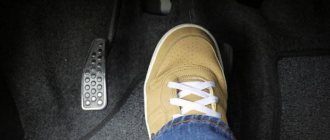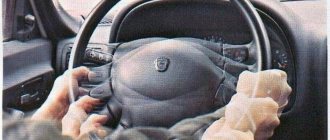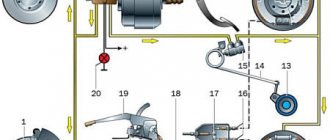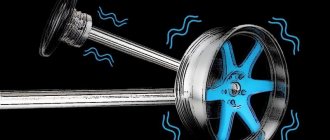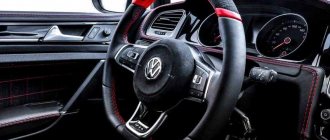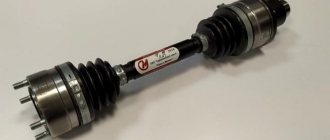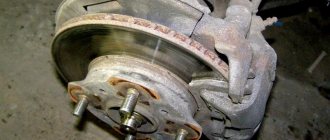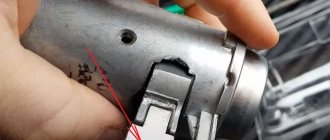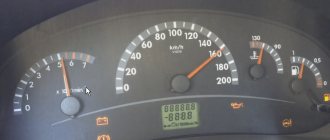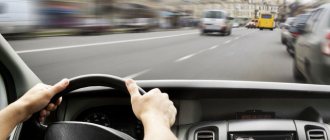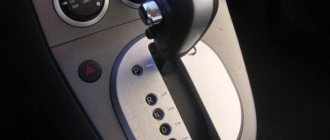Hi all! Please tell me those who HAVE FACED AND SOLVED this problem: after 100 the steering wheel starts to shake when braking. And the body shakes a little too. Are the brake discs bad? Or are the stamps crooked?
Comments 30
How can the rear drums hit the steering wheel? Why are you people? here is a question about the front part of the car, it was the same garbage. Question about the disc pads, caliper (which is unlikely), but for me it was due to crap wheel balancing (they stuck weights on me at the tire shop)
Did the drums make the body shake?
It was hammering into the steering wheel, bless you. And if you have vibrations in the body, put the person in the back. It will be clearer to him where the vibration is coming from. To exclude the back part. He if it's all the same from behind. he'll smell it right away))
I accidentally put a question mark) it happened to me before. And now it’s definitely the front
sharpen the brake discs or replace them with new ones))))
If it hits the steering wheel when braking, then it’s the brake discs that are crooked, and if it hits only the pedal, then it’s the brake drums. I think so...
By the way, exactly! When the drums beat, they hit the pedal and not the steering wheel)
If it hits the steering wheel when braking, then it’s the brake discs that are crooked, and if it hits only the pedal, then it’s the brake drums. I think so...
It hits both the steering wheel and the pedal. The car is running along the road. The steering wheel is like a joystick with vibration trying to jump out of your hands.
If it hits the steering wheel when braking, then it’s the brake discs that are crooked, and if it hits only the pedal, then it’s the brake drums. I think so...
I don't know where to go. I checked the brake discs for smoothness with a special device for runout. Everything is okay . I don't know what to do.
If the discs are straight, then you need to check all other components of the brake and chassis
It was the same crap, I changed the front pads, put them on softer ones, everything stopped
I had this happen. I changed the front brake discs, it didn’t help. I changed the rear drums, everything went away. But after 25 thousand km, it started beating a little again.
Also, if you brake from 150-180, somewhere around 120-100 km... The whole car shakes, it bounces terribly on the highway... The mileage is 83,000, everything is original except the front brake pads... This never happened before, the wheels are balanced.
I have the same garbage, vibrations when braking. But my steering wheel also shakes at 110 km/h. I went to a tire shop to have the wheels balanced, but it turned out that 3 of my discs were bent, but not too much. Next Friday I’ll go and fix them.
But it doesn’t hit me at speed, only when braking
The discs were hard, there was the same garbage on the 15: discs, pads, bearings, crabs, changed balls, it didn’t work! The rail was a little damaged, perhaps it was making itself felt! When braking, the steering wheel almost tore out of my hands) but when I applied it hard, everything was normal... I just sold it, and the new owner immediately changed the rack and that’s it, the beating stopped)))
For me, on the contrary, if you press slightly, you hardly feel it, but if you press hard, the steering wheel just rips out of your hands
If there is a current when braking, then most likely the brake discs, or the caliper is sticking...
Got it, thanks) and thought more about it
By the way, someone said that it could be the rear drums
I had this problem on the 10k, I thought it was the brake discs, I changed them, they got smaller, but they still remained, I changed the drums and everything went away.
the same crap, I changed all the brakes to new ones, even changed the sorcerer, the steering wheel still shakes when I brake. H.Z where to dig. Replaced front discs and pads. Everything in the rear is new, the brakes are new. We just didn't get around to vacuum. And the rear wheels are smooth and tires are second season Yokahama
this is a poltergeist)
the same crap, I changed all the brakes to new ones, even changed the sorcerer, the steering wheel still shakes when I brake. H.Z where to dig. Replaced front discs and pads. Everything in the rear is new, the brakes are new. We just didn't get around to vacuum. And the rear wheels are smooth and tires are second season Yokahama
Interesting... did you change the brake drums? My steering rack is loose, I wonder if that’s why
Steering wheel shakes when braking
Steering wheel wobble when braking is a common reason why car enthusiasts turn to service stations, where they begin to “spin” them by inventing non-existent problems. The following reasons can be identified for the steering wheel wobbling during heavy braking:
- unbalanced wheels (solved by ordinary balancing);
- broken wheel bearing (the wheel can wobble noticeably and bounce into the steering wheel when braking);
- worn brake pads (5 minutes + basic DIY skills and brake pads replaced).
Most of the problems listed above can be solved in your own garage, if you have a jack and new pads (bearings), you will have to tinker with replacing the wheel bearing. It is worth choosing new spare parts especially carefully, especially for AvtoVAZ spare parts, which do not differ in quality, even original and new ones. The wheels can be balanced within 20-40 minutes at the nearest tire shop.
The steering mechanism is a single system; a breakdown of the mechanism will certainly lead to a breakdown of the interconnected element; if the steering wheel shakes when braking, it is worth conducting a comprehensive diagnosis of the vehicle's control systems and checking its suspension.
If the steering wheel hits hard when braking at high speed and pushes into the brake pedal, then the reason for the steering wheel beating is in the brake discs, which have become deformed and become unusable. This can be temporarily corrected by vigorous sanding. If possible, purchase new ones; it is better to take imported brake discs.
conclusions
Dear readers and car enthusiasts, if you feel that the steering wheel is vibrating when braking, or this happens at idle, or when picking up a certain speed, urgently call for service.
When braking, the steering wheel shakes for a reason; this annoying twitching is a symptom of serious and even dangerous malfunctions.
For my part, I wish you only pleasant driving, and let no problems distract you from driving the car.
Until we meet again, and, as they say, neither nail nor rod for you!
Tags steering
Why does the steering wheel shake at speed?
Why does the steering wheel shake at a speed of 100 km/h? The reason for the steering wheel beating in this case is not as clear as in the case of braking. The problem is typical for both the domestic automobile industry and foreign-made cars. The following reasons for the steering wheel beating at high speed are identified:
- wheel imbalance (it’s worth checking the front wheels);
- disc deformation (disc deformation is caused by physical impact on it during an accident or is associated with the current properties of the road surface);
- the appearance of a “hernia” due to damage to the tire (even a slight deviation in the wheel geometry leads to vibration);
- dirt adhesion and ice formation (adhered lumps of dirt become ballast, which creates additional load on the axles);
- incorrect wheel alignment or worn hub cap;
- pressure difference in the wheels (difference in resistance creates vibration);
- malfunction of the front suspension (wear of shock absorbers or silent block);
- faulty CV joint.
If the steering wheel shakes when driving, there is no need to hesitate in solving the problem. In order to get rid of an unpleasant knocking noise, you need to conduct independent diagnostics and deal with the defect. How to do it?
- The rims and wheels should be cleaned of dirt and the pressure in the front tires checked;
- It is worth checking the wheels, discs and brake pads for integrity (presence of a hernia, worn out disc, worn out brake pads, etc.);
- If after completing the first two steps no problems are identified, then you should try swapping the wheels.
How to solve the problem with vibrations in the steering wheel?
When brake discs wear out, there are 2 ways to solve the problem. Grooving and replacement. By changing an element of the system, you can forget about the steering wheel beating for a long time. Grooving allows you to get rid of vibrations and keep your budget safe. But the working life of the disk will decrease and a repeat procedure may soon be required.
It is recommended to replace on both sides at the same time. This way you will achieve the best effect and eliminate steering wheel beating.
Deformation of the steering rod, ends, brake calipers - replacement of the part that has become unusable is mandatory. Actions to give the spare part its original technical characteristics are doomed to failure. The effectiveness of such measures is extremely low.
In situations with tire damage, everything depends on the degree of wear and experience of the technician. Often the problem is resolved quickly and without undue burden on the budget.
Steering wheel shakes at low speed
If the steering wheel hits hard at low speed, then the following reasons for this problem can be identified:
- worn tires (it is better to buy new tires if bumps, bumps or hernias are clearly visible);
- internal tire wear (solved by removing a handful of worn rubber from the tire);
- damage to the disk, including severe damage (a bent edge or even a “figure eight” on the disk);
- poor balancing.
Be sure to check the Ackermann angle and caster angle, the incorrect installation of which can affect the service life of car parts. Any violation of the wheel geometry leads to vibrations; if these vibrations are not noticeable at high speed, it means that the problem has not yet developed into a disaster.
Steering wheel wobble on bumps
If the steering wheel hits on bumps, then in addition to the above-mentioned problems, the steering mechanism may also break. The following reasons for the steering wheel beating on bumps can be identified:
- the steering shaft crosspiece is worn out (the problem can be solved by replacing or repairing it);
- excessively long suspension of the car during repairs (the sagging suspension will return to its original state in about 12-24 hours and the beating will disappear);
- wheel alignment (not a common cause of runout).
The beating of the steering wheel on bumps is often accompanied by a knocking sound in the steering column. It often turns out that by eliminating the cause of the knocking, the beating goes away.
Where to look for problems?
It is noteworthy that it can hit the steering wheel when braking on any car - VAZ-2108, Priora, Kalina, Ford Focus 2, Mitsubishi Lancer 9 and others.
No matter what vehicle this phenomenon occurs on, the malfunction must be eliminated urgently, and its sources must be looked for in:
- brake system (disc and calipers);
- steering;
- suspension;
- wheels.
Often car owners have to completely go through the above mentioned elements of the car in order to fix the problem.
The appearance of beating in the steering wheel during braking can occur for various reasons, for example, wear or damage to the components of the chassis, for example, a bent disk.
What are the consequences of ignoring the problem?
If you regularly hit the steering wheel while driving and you are even used to it, you should not think that the problem will not have consequences. Experienced car enthusiasts probably know that even the most wear-resistant mechanisms cannot tolerate frequent and strong vibration. It can damage almost any mechanism. It also does not have a positive effect on the driver. Please note that steering wheel vibration may increase over time. For example:
- For some reason, the steering wheel began to shake slightly. The problem is ignored;
- Tires wear out more. The beating becomes stronger;
- Bearings, suspension components, and individual elements of the steering mechanism wear out greatly. Driving a vehicle becomes much more difficult.
Experts are confident that the main problem with vibrations is the wheels, and in some cases, the brakes. The suspension of a car with a constantly vibrating steering wheel simply becomes weaker over time and its individual element may fail much earlier than expected. The danger here is that the driver of a problematic car becomes less attentive and more irritable, which, coupled with the technical shortcomings of the vehicle, can cause an accident.
Brake system elements
Most often it hits the steering wheel when braking due to problems with the system of the same name. And this can happen due to:
- DEFORMATION OF BRAKE DISCS. This is one of the most common reasons. As a result of friction with the pads, the brake disc heats up quite strongly during braking, and if it is cooled sharply (for example, water from a puddle immediately gets on it), it warps (its geometric shape is disrupted). The curvature of the working surfaces of the disc leads to runout in the pads, which is transmitted to the caliper, and from it, in turn, to the hub and steering rods. But warping of the rear brake discs or drums will turn into strong vibration of the body. The problem can be fixed either by grooving the brake discs (a method that allows work to be done without removing the element from the car) or by replacement;
- UNEVEN WEAR OF THE PADS AND THEIR DAMAGE. In this case, the runout will be caused by the uneven surface of the friction linings. Since the pads are worn in to the working surfaces of the brake discs, when replacing or turning the latter, they must be changed;
- WEDDING THE CALIPER. Often the caliper guides become stuck in their mounting holes. Because of this, the caliper will press the pads unevenly when braking and the driver will feel a beating in the steering wheel. Everything can be “cured” by disassembling the unit, cleaning and lubricating its guides and their seats.
Note that problems with the braking system often manifest themselves not only in the steering wheel, but also in the brake pedal.
Also, in the case of a jammed caliper, the car may brake unevenly (jerky).
Knowing additional symptoms can significantly narrow down the search for the causes of the malfunction.
How to avoid car brakes from squealing
If the brake pedal begins to vibrate when pressed, then this problem will not go away on its own. It is necessary to diagnose the machine as soon as possible and eliminate the malfunction. To avoid such troubles in the future, you need to follow these recommendations:
- Monitor the brake fluid level in the reservoir;
- Regularly check the brake system for leaks;
- Change the pads on time, without waiting for their maximum wear.
The braking system is nothing to joke about, and at the first symptoms of its malfunction, the problem should be eliminated.
(422 votes, average: 4.56 out of 5)
Steering
Here, the steering wheel may hit the steering wheel when braking due to worn or misadjusted steering elements.
At the same time, many believe that if there is play in the steering, the beating will be constant while driving, but we are considering the occurrence of impacts only when braking.
But this is not entirely true, and in order to understand how wear of the steering mechanism can affect the processes occurring when a car is braking, we should consider the theory a little.
The wheel always moves along the path of least resistance, and the higher the speed, the more difficult it is for it to change its trajectory.
When braking, the wheel slows down significantly, which can affect the trajectory of the latter.
If the steering mechanism is in good condition, it will keep the wheel in the desired path.
But if, as a result of wear, there is even a slight gap (1 mm), for example, between the rack and gear of a mechanism, then it will provide a lateral play of 3-4 mm on the wheel.
That is, the wheel will no longer be rigidly held, and it will be able to voluntarily change its trajectory within the range of available play, and this change is of a vibrational nature.
And from the wheel this vibration is transmitted to the mechanism and then to the steering wheel.
Therefore, if there is a beating in the steering wheel when braking, you should definitely check for play in:
- Rack and pinion pair;
- Steering tips;
- Cardan transmission of the steering column.
Using the HYUNDAI HD 72 as an example, it looks like this.
You should also definitely check the condition of the tie rods being attached to the rack.
Suspension and wheels
Approximately the same result is obtained by wear of some components of the suspension.
Silent blocks, ball joints, and support bearings that have exhausted their service life will cause the wheel to develop lateral play, which will be the source of the problem.
It should be noted here that an additional sign of wear on the suspension components is knocking noises when driving over uneven surfaces.
It’s not difficult to check the condition of the suspension; just swing the levers with a mount, and if the silent blocks and ball joint are worn out, this will be immediately noticeable during the check. But before that, check whether the disk is screwed on well; loosening at least one of the bolts can lead to vibration of the entire car.
Although rare, vibration is caused by the hub and its bearing. As a result of severe wear of the bearing seat, play appears in this unit, which will be manifested by impacts on the steering wheel.
The wheels may also hit the steering wheel when braking, so you need to check:
- Damage or imbalance of the disk;
- Loose bolts (usually happens when a car is “re-shoeed.” The bolts are simply forgotten to be tightened);
- Tire defects;
- Violation of camber/toe angles.
As you can see, there are two main causes of the problem: play in the chassis and damage to the brake system elements.
That is, the brake discs, due to overheating, the suspension and steering mechanism have not been serviced for a long time, new wheels are installed on the car, which have not been balanced and as a result the driver receives quite unpleasant and dangerous consequences.
avtoexperts.ru
Even if car enthusiasts react quite nervously to such common phenomena as the rattling of glass and plastic inside a car, vibration of the steering wheel can put almost every driver in a mental hospital - this is a very annoying and unpleasant process. Jokes aside, vibrations on the steering wheel are a very serious problem. Today we will find out the reasons for its occurrence and tell you how to cope with this disaster.
Causes of vibrations on the steering wheel
As a rule, vibrations in the steering wheel appear under various conditions: when the car is moving at different speeds, braking, or when the car is stationary and its engine is idling. If the beating of the steering wheel has become annoying, you need to determine in what circumstances it manifests itself, and depending on this, diagnose the cause.
Steering wheel wobble when the car is stationary
Vibrations in this case can occur for two reasons: due to loose engine mounts or due to problems with the steering rack drive shaft. In the first option, when the engine is idling, the steering wheel hits quite hard. Such vibrations appear on cars with high mileage: either the mountings of the power unit have become loose over time, or the engine was not installed properly after a major overhaul. If even at low speeds a significant beating of the steering wheel is felt, then as the speed increases, the vibrations increase and driving such a car becomes not only uncomfortable, but also unsafe.
The second option: the occurrence of vibrations at idle speed in a stationary car can be caused by wear of the splined part of the steering rack drive shaft or deformation of the shaft itself. With this option, the steering wheel runout may also increase when the car moves.
You cannot drive with such vibrations for a long time because it can lead to destruction of the steering mechanism elements, and, as a result, loss of control of the car - an accident.
Steering wheel vibration when driving at different speeds
Here there are more factors causing vibrations, and they are mainly related to the condition of the wheels.
Firstly, steering wheel beating can occur due to the fact that the wheel rims become clogged with snow or dirt, which leads to imbalance of the wheels and, as a result, the appearance of those same annoying vibrations. In this case, the steering wheel only shakes at low speeds, and when the speed increases, the vibrations disappear completely.
Secondly, steering wheel vibrations can occur at medium (no more than 60 km/h) and high speeds if the wheels were not properly balanced during a seasonal tire change or after tire repair.
In this case, the masses of the wheels become different; when the speed increases, the centrifugal forces of such wheels differ, which is why the steering wheel wobbles. You can’t drive with unbalanced wheels for a long time - in addition to driving discomfort, you can ruin the tires (uneven wear) or, more seriously, damage the suspension elements (in this case, the hub bearings suffer the most).
Thirdly, steering wheel beating can be caused by deformation of the wheel rims (most often steel wheels are susceptible to this). Most often, vibrations in this case occur after the car has crashed into a pothole with one or even two wheels. It happens that a deformed wheel rim is sold to you in a store or market - this is a manufacturing defect. It is not always possible to determine by eye whether crooked rims are the cause of vibrations on the steering wheel - often this bends the inner part of the rim, not the outer one.
You can diagnose this reason by removing the wheels yourself, or by contacting the nearest tire shop.
Fourthly, steering wheel vibration may occur if the holes in the wheel rim do not match the diameter of the bolts on the wheel hub. This manifests itself when non-original rims are installed on the car. In this case, the disc begins to “jump” on the hub, vibration occurs, which is transmitted to the steering wheel. The higher the speed, the more the steering wheel vibrates.
Fifthly, steering “fever” occurs due to tire defects. This includes deformation of the cord or sidewall of the tire, which can be caused by manufacturing defects or improper use of the rubber (driving on roads with potholes).
The sixth reason for vibration at speed is uneven tire pressure. Due to the fact that there are different pressures in the wheels on the same axle, the steering wheel begins to shake even at low speeds.
Another cause of vibration in the steering wheel, which can occur at medium and high speeds, is unevenly tightened or loose wheel bolts. In the first case, due to the fact that the bolts are tightened with different forces, a misalignment occurs when the wheel rotates. The greater its centrifugal force, the stronger the distortion and the more noticeable the beating of the steering wheel. In the second case, if the bolts are loosened, the wheel begins to “jump” on the hub, generating vibrations that radiate into the steering wheel.
Finally, worn-out suspension or steering components can lead to vibrations in the steering wheel. Wear of these parts leads to the appearance of backlashes of various sizes, and the larger they are, the more severely the steering wheel hits at speed. In this case, the appearance of vibrations on the steering wheel serves as a signal to check the suspension or steering elements. For example, vibration in the steering wheel may occur when cornering. Worn constant velocity joints (CV joints) or failed silent blocks of the front arms are to blame for this. And if the steering wheel shakes when driving over bumps, we risk breaking the steering rack bushings.
Steering wheel wobble when braking
Vibrations in the steering wheel when braking occur due to deformation of the elements of the car's braking system - brake discs or drums. A change in the shape of discs or drums can be caused by a) a manufacturing defect; b) improper operation of the brake system (overheating of the brake discs followed by sudden cooling).
How to fix vibrations on the steering wheel
Having determined exactly why the steering wheel is beating, you can begin to correct this defect. Let's talk about how to get rid of vibrations on the steering wheel in the same order in which we determined the causes of their occurrence.
1. Secure the engine. Using suitable keys, we tighten all the engine mounts, with which it is fixed in the engine compartment. If the fastening is broken or the bolts, washers and nuts are worn out, we replace them with new ones. In order to ensure reliable fastening, we wrap flax tow soaked in grease around the bolt.
How to identify the cause?
Since there are quite a lot of elements that can create this problem, in order to identify exactly what caused the beating in the steering wheel, the search should be carried out progressively.
First of all, check the wheel balancing at a tire service station, and then contact a specialist to adjust the camber/toe angles.
These jobs should be done first because they require specialized equipment and cannot be done in a garage.
As for the wheels, you can do things a little differently if you have another set of them. To make sure that the reason lies precisely in them, you need to install a second set on the car and check the car’s behavior on the track.
If the vibration in the driver’s hands during braking disappears or decreases, it means that the wheels that were installed previously require maintenance - rolling the discs, balancing. In extreme cases, they can be swapped, front to rear and vice versa.
Next, you should check the condition of the brake discs, since they are the most common cause of failure. To do this, remove the front wheels from the car and visually assess the condition of the discs and calipers.
If defects are noticeable on their working surfaces - cracks, stripes, changes in the color of the metal (when overheated, the surface acquires a blue tint), or unevenness is felt to the touch, then there is a high probability that it is because of them that the steering wheel is hitting.
Check the tires for various bulges such as “ghouls”, etc.
If the brake discs are in order and their working surface is mirror-like and smooth, we remove the calipers from the car to assess the condition of the pads and guides.
When checking the brake system, you should evaluate the condition of the wheel bearing. To do this, grab the brake disc from above and below with your hands and swing it forcefully.
Play in the hub is not allowed and if it is detected, the bearing must be replaced, and if the seat is worn out, the hub must also be replaced.
After checking the condition of the brake components, we move on to the suspension.
Here you should check for play in silent blocks, ball joints and support bearings.
On a FIAT Linea, a worn support bearing looks like this.
By swinging the levers with a mount and your hands - the shock-absorbing strut itself, you can identify backlashes and eliminate them by replacing worn elements.
Finally, the condition of the steering mechanism is checked. Be sure to evaluate the condition of the steering tips, and also adjust the engagement of the rack-and-pinion pair. Don't forget about the steering column driveshaft.
By checking all components of the chassis, you can find the cause of the steering wheel beating when braking and eliminate it.
But as indicated, the reason may lie in several points at once, then you may have to carry out comprehensive maintenance of the car with the replacement of consumables and worn-out components.
Be sure to read: Car vibration, causes, solutions.
Steering wheel vibration when braking, as a result, replacement of Hyundai Grand Santa Fe brake discs.
Vibrations sent into the steering wheel after changing the disc, hub or bearing
If you notice that vibrations reverberating through the steering wheel or body of the car were detected after work was carried out in a car repair shop, then you need to look for the cause of this misfortune there. Such shaking could be caused by a previous change of the brake disc (as well as the hub bearing or the entire hub), which from time to time causes the steering wheel to shake. Usually this happens due to low-quality replacement elements, although coupled with this is an irresponsible attitude towards the procedure for replacing parts. The disk could have been tightened with the wrong force, or the disk could have been installed crosswise without tightening. The torque that should be applied to tighten is often indicated directly on the disc.
If runout on the steering wheel or body of the car was detected after operations on the chassis of the car, try to involve the same specialist who performed these operations on the chassis.
